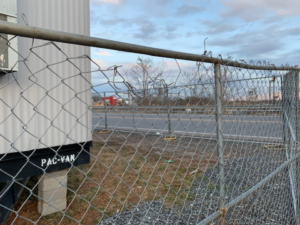Issues with chain link temporary fencing
Issues with chain link temporary fencing
You’re probably already aware that chain-link mesh is the primary material used as temporary fencing in the US, but what you probably haven’t realized is that welded wire mesh offers a safer, stronger and more cost effective solution for your temporary fencing needs.
Although chain-link fencing has been the the default material used for temporary fencing for over 100 years and is used everywhere from construction to crowd control, there are many issues that have arisen given its composition and design that make alternative materials, such as welded wire mesh, more sensible for temporary fencing.
Below are 5 main issues that arise with chain-link fencing that limit its performance.
High Maintenance
Although chain-link fencing appears to be a sturdy and resilient material, its woven design actually creates structural limitations that can increase its maintenance costs over time. The woven steel found in chain-link panels lacks the structural rigidity to with stand consistent contact and modifying force, leaving it susceptible to damage and breakage within the woven strands. Unfortunately, given that the design requires the integrity of all of the strands to ensure maximal security measures, if any of the links break, the integrity of the fence is severely compromised.
In order to compensate for the reduction in security, those who invest in chain-link fencing must provide consistent surveillance to ensure that the fence is in usable form. This creates added labor demands and costs that can outweigh any cost reductions chain-link fencing might offer. It should be no surprise that the rise in instructional content and professional services relating to repairing chain-link fencing continues to rise, indicating the limitations in performance this material offers.
Beyond the reduction in limiting movement through the fence, breakages can also be a safety concern for those passing by who might get caught on the protruding metal, creating cut or abrasion hazards. This risk only amplifies the legal concerns associated with faulty fencing.

Compromised Security
Given that chain link fencing is generally used as a barricade to limit or prevent movement to controlled areas, the scalability of chain-link fencing creates another significant security limitation.
Beyond the potential for being damaged from incidental contact, chain-link fences are relatively easy to scale or cut through. Most chain-link fences have 2.25″-2.5″ apertures which provides sufficient space as hand and footholds when climbing them. As already noted, if there is a breakage in the fence, it becomes much easier to stretch or move the surrounding links to widen this opening, effectively negating the presence of the fence.
Welded wire mesh offers many benefits in this capacity, as its smaller apertures make it very difficult to climb while the welded wire creates a much stronger and continuous material that is much harder to cut through, vastly increasing the security capabilities of such temporary fencing. See our Smartweld temporary fence panels.
Safety Concerns
Amplifying the security limitations of chain link fencing are the potential problems that may arise for
workers and children in the area. If a fence is broken and has been further compromised with repeated entry, it can create an opening large enough for children to pass through, posing a substantial security concern if the area being protected is a minimally monitored, but sufficiently dangerous construction site.
Likewise, any breakages of protruding metal can create a safety concern for workers who handle the panels or members of the public that inadvertently pass by and get scraped or caught on the fence. This issue has only been getting worse in recent years, with a report showing a 94% rise in yearly injuries caused by temporary fencing between 2016 and 2018.
Storage Issues
Storage and set up of chain link temporary fencing panels is notoriously difficult, with panels becoming tangled easily. Untangling chain link takes time, causes injury and can even damage the panels.
Problems with Quality
A recurring issue that has plagued the market is the inconsistency in product quality. MIG welding is commonly used to produce chain link fencing panels. MIG welding is open to human error as well as limiting the number of welded points used to secure the chain link to the frame.
The Alternative
All of these issues add up to major problems for both rental companies and the end users. The current market is flooded with products that do a job, but do not do it well and this leads to unnecessary injuries, loss of productivity, costs & and overall lower return on investment. ZND’s welded wire mesh fencing panels solve all of these issues, see how they can benefit your business.
James Murphy
James Murphy spent over 10 years in the rental industry before taking the role of President of ZND US in early 2019. ZND US is the latest branch of the world’s leading temporary fencing manufacturer ZND. ZND US have invested over $8 million in a new automated production facility in North Carolina. This investment brings sorely needed innovation to the US temporary fencing market. For the first time, sites in the US have a viable and affordable alternative to chain link. Connect with James Murphy over LinkedIn for more updates.
